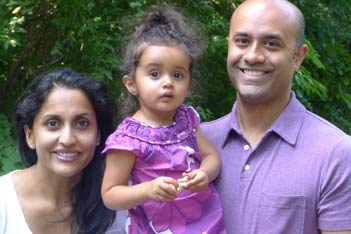Activating Brain Tumor Stem Cells During Intra-operative Chemotherapy
Recently appointed to the neurosurgery staff at St.
Michael’s Hospital, Sunit Das has a focused interest in
malignant diseases of the brain, skull base and endoscopic
neurosurgery. He will next add gamma knife
radiosurgery to his skill set.

Sunit Das with his wife Pavani and their daughter Lakshmi
Sunit attended medical school at Northwestern
University and then completed a neurosurgery residency
there under Hunt Batjer, one of the great neurosurgical
experts on vascular malformation. Batjer trained under the
iconic Canadian neurosurgeon Charles Drake. Hunt is a
Dallas Texan who creates an exceptionally calm atmosphere
in the operating room. Hunt referred Sunit to his friend Jim
Rutka during Sunit’s second year of neurosurgery residency.
Jim has been a mentor ever since, writing supporting letters
for every grant application, arranging for him to give talks
and serve on committees to foster his career.
Sunit completed a PhD at NIH, focused on synaptic
maturation and neural stem cell biology. “It was a fantastic
place to learn, working with mentor Xuan Cheng
and surrounded by spectacular scholars.”
In his laboratory in the MaRS building, Sunit he is working
with glioma and glioblastoma stem cells. His focus is on
signaling in the cell cycle, looking at signaling families at the
EMT (epithelial mesenchyma transition). This is a pathway
that has been actively and productively explored in breast
cancer. The EMT interface maintains stem cells in a quiescent
stage, but it is disrupted in gliomas and glioblastomas.
The second pathway that he is studying is endothelial cellsignaling
via prostacyclins. The prostacyclins maintain two
niches in the brain where stem cells reside - in the subventricular
area and the subgranulosa zone. Other signals push
these cells toward differentiation, while vascular endothelial
prostacyclins maintain them in equilibrium.
|
Sunit came to Toronto in order to combine clinical
work with scientific work at a level that enables a surgeon
scientist to keep his skills together. He will link
clinical trials to laboratory investigations - for example,
an RTOG (Radiation Therapy Oncology Group) trial
working with 5 ALA, a compound that fluoresces when
metabolically active cells break down. Resistance to
chemotherapy is associated with stem cells. He hopes to
be able to drive cells away from the stem cell phenotype
to increase their sensitivity to chemotherapy and attack
them with adjuvant treatment at the time of surgery. He
will model his laboratory – based clinical work on the
Brain Tumor Unit at the Hospital for Sick Children.
Sunit was born in Dhaka, Bangladesh, moved to
New York city as an infant and subsequently moved to
Detroit. He grew up as an immigrant Indian-American
and as a scholar - athlete. He entered the honours program
in English literature at the University of Michigan
Ann Arbor and became interested in the life of the mind.
He then studied political philosophy in graduate school
at Harvard under Cornell West. He became interested in
the philosophy of Locke, Wittgenstein and Heidegger.
He considered pursuing philosophy or neuroscience and
fortunately chose the latter. One of his surgical mentors
was Mark Telemanti, a gifted surgical oncologist and
highly praised and beloved clinician.
Sunit’s family includes his wife Pavani, a medical school
classmate at Northwestern, and their two year old daughter
Lakshmi. Pavani is a specialist in infectious disease, working
at North York General and consulting for the Ontario
Agency for Health Promotion. His dad is a pediatrician and
his maternal grandfather was a military physician. Sunit
runs and bikes and his wife skis. Sunit is currently reading
the Anatomy of Influence by Harold Bloom, the dean of
American literary critics and one of Sunit’s former teachers.
M.M.
|